Staking Crypto on Ledger : How does it work and how to start?
Staking Crypto on Ledger allows you to generate passive income using its Ledger wallet securing Proof of Stake Blockchains. But how does it work exactly and how to start quickly ? Here is everything you need to know.
Table of contents
What is staking Crypto with a Ledger ?
Crypto staking designates the fact of blocking a quantity of cryptocurrencies on a blockchain using a consensus mechanism called proof of stake ( Proof of Stake , or staking ) . In exchange for this contribution to the security and validation of network transactions, participants receive staking awards , generally in native cryptocurrency.
When you use a physical wallet like the Ledger Nano , you keep the exclusive control of your funds: private keys never leave the device. Ledger does not take possession of your cryptos. You sign each transaction locally from your secure key. Ledger models since staking is done via Ledger LIVE identically for Ledger models .
The role of validators in staking
To understand staking, you have to know the central role of the validators. On a POS Blockchain, they are the ones who offer and validate the new blocks. In return, they receive part of the transaction costs and/or new cryptocurrency units issued (depending on the monetary policy of the network).
If you do not wish to exploit a node yourself (which requires considerable technical and financial resources), you can simply delegate your tokens to a validator. You thus participate indirectly in the process while remaining the owner of your cryptos. This is how the great emajeurity of users participate in staking .
Rewards and sanctions: what you need to know
Here are the two sides of the staking :
- Rewards : they vary depending on the network, the amount put into play, and the performance of the validator (uptime, number of validated blocks, etc.). They can be paid daily every 72 hours, or at the end of a period, according to the blockchain.
- Sanctions ( Slashing ): If the validator acts maliciously or does not remain online, part of the Staké funds can be penalized .
Delegating does not mean abandoning the property of your funds. What you delegate are your participation rights (vote, validation) to the validator. Your private keys remain on your Wallet Ledger . You can stop staker and recover your funds at any time, depending on the reverse delegation specific to each blockchain (from a few hours to several days).
Minimum amounts required according to blockchains
Each network has its own rules for staking. Here are some concrete examples:
- Ethereum (ETH) : 32 ETH to be validator, but you can delegate any amount via providers in Ledger Live.
- Solana (SOL) : no strict minimum, but it is advisable to keep at least 0.01 non-staked SOL for costs.
- Polkadot (DOT) : often minimum of 10 DOT for the delegation according to the validators.
- Tezos (XTZ) : no official minimum to delegate.
- Cosmos (Atom) : generally from 0.05 Atom, but depends on the validator.
This information is visible directly in the LEDGER LIVE winning tab , which adapts Ledger interface to the selected crypto.
Why do staking with Ledger ?
Here is what distinguishes staking via a Wallet Ledger from centralized exchange platforms ( CEX ) like Binance or Bitvavo:
- Personal conservation : You are the only one to have access to your assets thanks to the Ledger .
- Free choice of the validator : via Ledger Live, you choose who to delegate ( Ledger by Light, Lido, Stade, etc.).
- Total transparency : Commission costs are clearly displayed and generally lower than on CEX.
- Less centralized risks : you do not depend on the solvency of a platform, as has been a problem with FTX or Celsius.
How does staking on Ledger Live work?
Ledger LIVE allows you to easily manage your digital assets and to participate in staking independently. You freely choose the validators to maximize your gains and manage your assets directly from the application.
Assets supported by Ledger Live for staking
Several popular cryptos are compatible with Ledger LIVE:
- Ethereum (ETH) - APR approximately 2.98 %
- Solana (SOL) - APY approximately 8.61 %
- Cosmos (ATOM) - APY about 19.01 %
- Polkadot (dot) - APY approximately 10.66 %
- Osmosis (OSMO) - APY approximately 24.00 %
- Others: Cardano (ADA) , Tezos (XTZ) , Avalanche (Avx) , Injective (INJ) , etc.
Each asset offers a different interface to delegate your tokens to a validator.
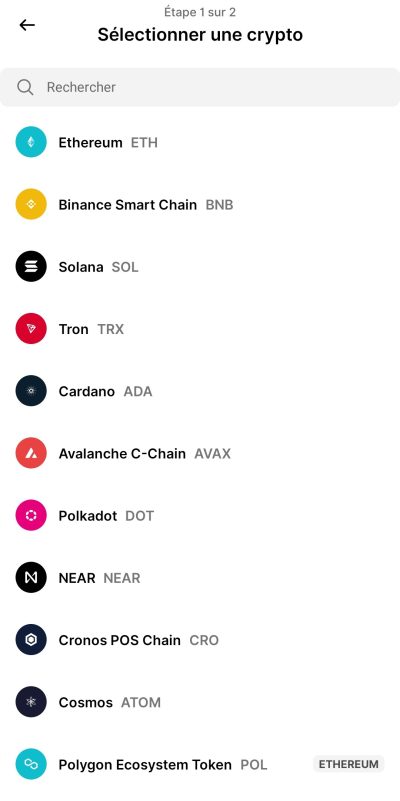
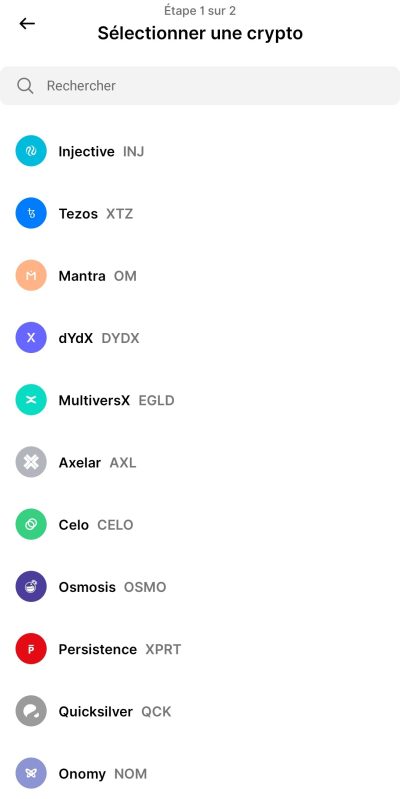
Example with Solana : how to stike your Solana (SOL) with Ledger Live
Here is a detailed guide for staging your soil via your Ledger . Add the screenshots to the stages specified below to facilitate understanding:
Step 1: Prepare your Ledger
- Connect your Ledger at Ledger Live.
- Install or update the Solana on your Ledger .
Step 2: Transfer your soil to your Ledger wallet
- From an exchange or another wallet, transfer your soil to the address provided by Ledger Live.
- Wait for a few minutes to confirm the transaction.
Step 3: Start in staker via Ledger Live
- win on Ledger tab .
- Select Solana , then click on your account then "Delegate to win rewards".
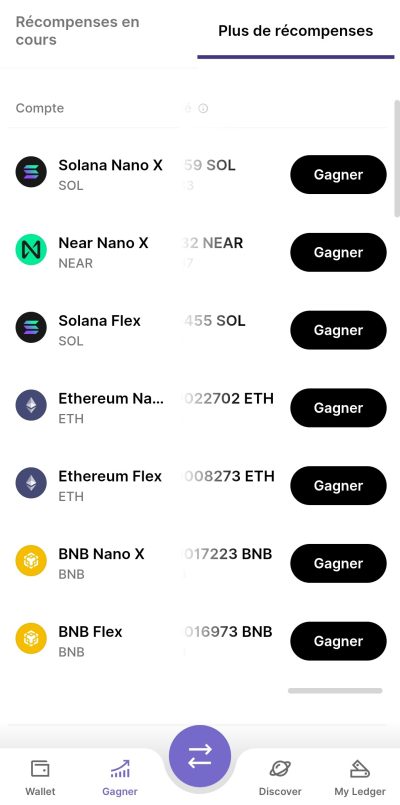

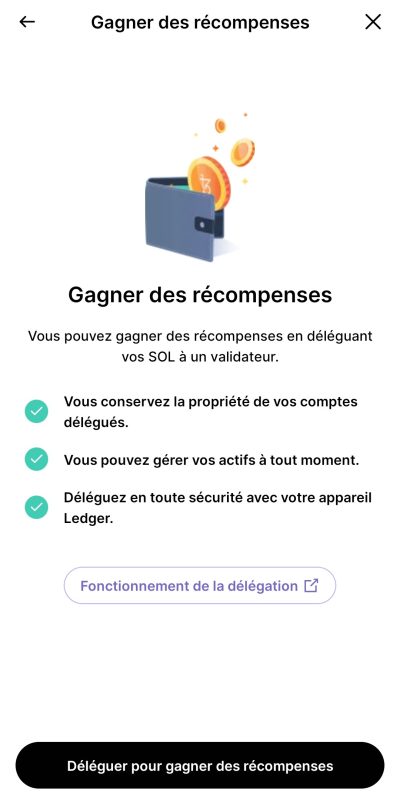
Step 4: Choose a validator
In this stage, you must select a validator to delegate your participation rights.
Each validator collects a commission, expressed as a percentage, which corresponds to the share of the awards it keeps to remunerate its service. For example, " Ledger by listed (commission: 7 %)" means that this validator retains 7 % of the gains generated before paying you the rest. These costs are automatically taken and require no action from you.
To choose a reliable validator, take into account the following criteria:
- Commission rate : a reasonable rate, neither too high nor too low (often between 5 % and 10 %).
- Uptime rate : a validator constantly online is more likely to receive regular rewards.
- History of penalties : Avoid validators having been "slashed" for faults or inactivity.
- Reputation : favor known validators supported by recognized entities such as Ledger by is not .
Where to find key information on validators?
- Commission rate : - In Ledger LIVE, when you select an asset (ex: Solana, Ethereum, Polkadot, etc.), the available validators appear with their commission rate indicated as a percentage. - For more details, you can consult specialized blockchain explorers such as:
- solana Beach.io for Solana
- mintcan.io for cosmos
- polkadot .js.org for Polkadot
- Uptime rate :-displayed directly in the explorers of validators mentioned above. - The rate of uptime reflects the regularity with which a validator remains connected and operational. A uptime close to 100 % is ideal.
- History of penalties (SLASHING) : - This information is generally available in the details of the validator on blockchain explorers. - A validator having been "Slashed" was sanctioned (e.g. double signature, prolonged inactivity), which can affect your awards or even lead to a partial loss of delegated funds.
- Reputation : - Check if the validator is associated with a known organization (ex: lighter , Ledger , Binance , etc.).
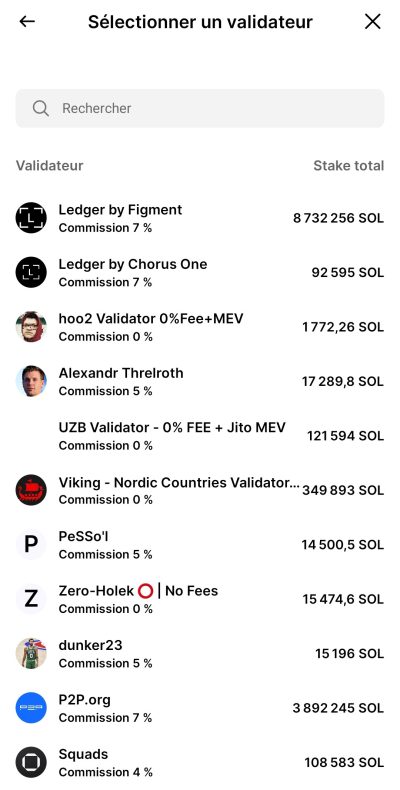
Step 5: Confirm the delegation
- Choose the amount to delegate (keep approximately 0.01 ground available for costs).
- Validate the transaction with your Ledgerdevice.
Step 6: Check your staking rewards
- Your rewards will appear directly in your Staké balance about 2-3 days later.
- Follow them easily in the Ledger Live win tab.
(Screenshot to insert: follow -up of rewards in Ledger Live)
Differences between staking on Ledger and exchange platforms
Unlike platforms like Binance :
- With Ledger , you keep total control of your assets thanks to your private keys .
- You choose your validator, which is not possible on most centralized exchanges (CEX) .
- Ledger does not pay for additional hidden fees.
Risks and precautions related to staking with Ledger
Even with a physical wallet:
- staking still has risks related to network performance.
- Do not delegate all of your assets in order to be able to pay any transaction costs.
- Always choose recognized validators.
Conclusion: staking Crypto Ledger, an effective solution?
staking Crypto via a Ledger Wallet represents an excellent solution to generate passive income while keeping absolute control of your cryptos. Ledger Live considerably simplifies staking management and maximizes safety by retaining private keys to your personal device.
FAQ on staking Crypto Ledger
What is a crypto validator?
A validator is an actor of the blockchain responsible for confirming the transactions and securing the network.
What is the difference between APR and APY ?
The APR is a simple annual rate, while the APY includes the effect of compound interest.
Can you remove your cryptos at any time from staking on Ledger ?
Yes, but depending on the blockchain, a delay of a few days may be necessary to completely free your funds.
Does Ledger pay fees on staking rewards?
No, Ledger does not pay additional costs on the rewards won.
Investments in cryptocurrencies are risky. Crypternon could not be held responsible, directly or indirectly, for any damage or loss caused following the use of a property or service put forward in this article. Readers must do their own research before undertaking any action and investing only within the limits of their financial capacities. Past performance does not guarantee future results. This article does not constitute an investment .
Certain links of this article are sponsorship links, which means that if you buy a product or you register via these links, we will collect a commission on the part of the sponsored company. These commissions do not train any additional cost for you as a user and certain sponsorships allow you to access promotions.
AMF recommendations. There is no guaranteed high yield, a product with high performance potential implies a high risk. This risk taking must be in line with your project, your investment horizon and your ability to lose part of this savings. Do not invest if you are not ready to lose all or part of your capital.
All our articles are subject to a rigorous verification of the facts. Each key information is verified manually from reliable and recognized sources. When we cite a source, the link is systematically integrated into the text and highlighted by a different color, in order to guarantee transparency and allow the reader to consult the original documents directly.
To go further, read our pages legal notices , privacy policy and general conditions of use .

